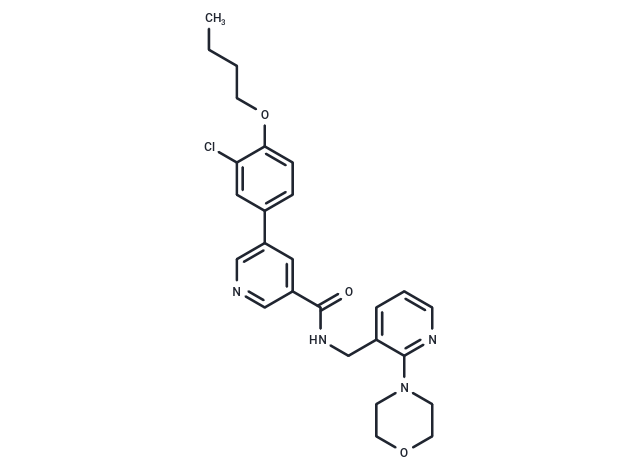Shopping Cart
- Remove All
 Your shopping cart is currently empty
Your shopping cart is currently empty

A-887826 is a selective, orally bioavailable, and voltage-dependent Na(v1.8) channel blocker (IC50: 11 nM). It attenuates neuropathic tactile allodynia in vivo.


| Description | A-887826 is a selective, orally bioavailable, and voltage-dependent Na(v1.8) channel blocker (IC50: 11 nM). It attenuates neuropathic tactile allodynia in vivo. |
| Targets&IC50 | Nav1.8:11 nM |
| In vitro | A-887826 exhibits variable potency in blocking sodium channels, being approximately three times less effective against Na(v)1.2 channels, about ten times less effective in blocking tetrodotoxin-sensitive sodium (TTX-S Na(+)) currents, and over thirty times less effective against Na(v)1.5 channels. However, it demonstrates significant efficacy in blocking tetrodotoxin-resistant sodium (TTX-R Na(+)) currents with an IC50 of 8 nM in small diameter rat dorsal root ganglion (DRG) neurons, acting in a voltage-dependent manner. It potently reduces both evoked and spontaneous action potential firing in DRG neurons at depolarized potentials and in neurons from rats with inflammation due to complete Freund's adjuvant. A-887826, at a concentration of 100 nM, specifically alters the voltage-dependent inactivation of TTX-R currents by about 4mV, without impacting voltage-dependent activation, and does not show frequency-dependent inhibition. |
| In vivo | A-887826 (3-30 mg/kg; p.o.; 1-hour pre-treatment) significantly reduces tactile allodynia in a rat neuropathic pain model. |
| Animal Research | Animal Model: Male Spraguee Dawley rats (200-300 g). Dosage: 3 mg/kg, 10 mg/kg, 30 mg/kg. Administration: p.o.; 1 hour before testing; fourteen days after L5-L6 spinal nerve ligation |
| Molecular Weight | 480.99 |
| Formula | C26H29ClN4O3 |
| Cas No. | 1266212-81-0 |
| Relative Density. | 1.230 g/cm3 (Predicted) |
| Storage | Powder: -20°C for 3 years | In solvent: -80°C for 1 year | Shipping with blue ice. |

Copyright © 2015-2025 TargetMol Chemicals Inc. All Rights Reserved.